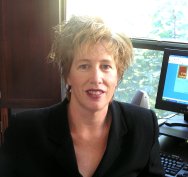Dr. Mary Lou Jepsen
The Reuters article New screen technology may hit stores Dec — designer said
Computers and cell phones with screens that can be read in direct sunlight could be on store shelves by the end of this year, the designer of the breakthrough display technology said.
The high-resolution monitors switch from color to black and white, allowing the screens to be clearly viewed in direct sunlight, a feature unavailable in current high-end laptop computers that cost thousands of dollars.
The display was developed by Mary Lou Jepsen while she was working for the One Laptop per Child Foundation, which produces low-cost computers for poor children around the world.
Jepsen left her post as chief technology officer at the foundation at the end of last year to start her own company, Pixel Qi, which will license the display technology.
Mary Lou Jepsen, Ph.D. is
CEO/CTO of
Pixel Qi.
Pixel Qi is currently pursuing the $75 laptop, while also aiming to
bring sunlight readable, low-cost, and low-power screens into mainstream
laptops, cellphones, and digital cameras.
Mary Lou was previously the founding chief technology officer of
One Laptop Per Child (OLPC). Notably she invented the laptop’s sunlight-readable
display technology and co-invented its ultra-low-power management system.
Critically, she transformed these inventions into ready-to-ship
hardware, integrated into the XO laptop — the lowest-cost laptop
ever
made and the most environmentally
friendly laptop ever made.
She convinced some of
the world’s largest electronics manufacturers to create the XO with her,
and she managed the relationships between OLPC and them.
Spinning Pixel Qi out from OLPC enables the development of a new
machine, beyond
the XO, while leveraging a larger market for new technologies, beyond
just OLPC: prices for next-generation hardware can be brought down by
allowing multiple uses of the key technology advances. Pixel Qi will
give OLPC products at cost, while also selling the sub-systems and
devices at a profit for commercial use.
Previously Mary Lou’s contributions have had worldwide adoption in
successful head-mounted display, HDTV, and projector products. She has
been a pioneer in single-panel field-sequential projection display
systems and liquid-crystal-on-silicon SoC devices. She cofounded the
first company whose sole effort was the development of microdisplays in
1995 (The Microdisplay Corporation) and served as its chief technology
officer through 2003. Until the end of 2004, she was the chief
technology officer of Intel’s Display Division.
She authored
Why Analog Silicon May Be Best for LCOS Digital TV and
LCoS Rear Projection Television:
A comparison of single and multi-panel projection engines, and
coauthored
Electronic display system for computational holography,
Liquid-crystal-filled gratings with high diffraction
efficiency,
Optical Transfer of Master Hologram with 20 Meter Depth,
MicroDisplay Subsystem of a Wireless Handheld Computer, and
Rectangular surface-relief transmission gratings with a very large
first-order diffraction efficiency (~95%) for unpolarized light.
Read the
full list of her publications!
She co-created the first holographic video system in the world at the
MIT Media Lab in 1989, where the interference structure of the hologram
was computed at video rates, and shown on her hand-made display. This
system inspired a whole new field of holographic video and received
numerous awards. Her PhD work combined rigorous theoretical
coupled-wave analysis with
lab work, in which she created large-scale, embossed surface-relief
diffraction gratings with liquid crystal-filled grooves with high
diffraction efficiency in un-polarized illumination.
Her patents include
Reflective liquid crystal display with integrated compensation for
skew
angle rotation and birefringence effects,
Method and apparatus for forming optical gratings, and
Thin cell gap microdisplay with optimum optical
properties.
Mary Lou earned a PhD in optics (1996), a BS in electrical engineering
(1987) and a
BA (req.) in studio art (1987) all from Brown University as well as an
MS
in holography (1989)
from
the MIT Media Lab.
Read
A Conversation with Mary Lou Jepsen,
Interview with OLPC’s Founding CTO Mary Lou Jepsen, and
Future of computer design lies beyond CPU.





